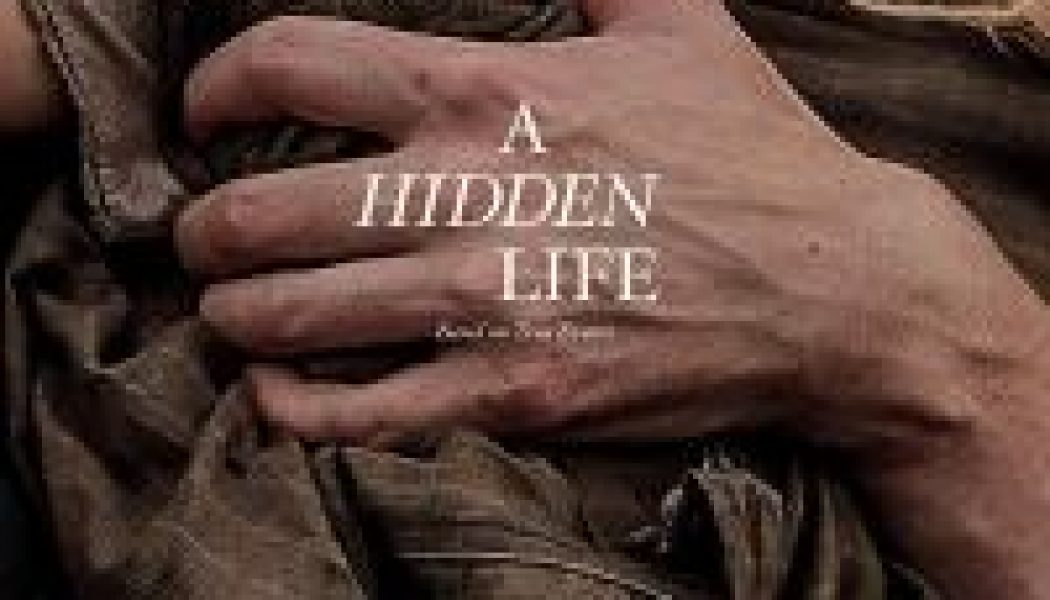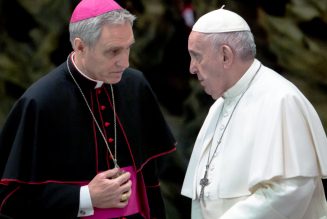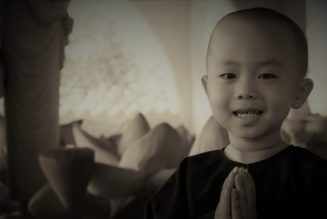Terrence Malick’s “A Hidden Life” does not drag. Its deliberate pace describing why its protagonist—a Catholic who defied Hitler’s Reich by refusing military service—died is a moving icon, a window into that mystery of why and how silence and conscience lead to true freedom.
“There isn’t any twirling, is there?” I asked my former student Emily and her mother. They were emerging from the 4:30 showing of Terrence Malick’s powerful new film about Franz Jägerstätter, an Austrian villager who decided to defy the Reich by refusing military service or even service as a medical orderly if it involved swearing allegiance to Hitler.
I was there at the Uptown Theater in Minneapolis for the 8 P.M. showing with my three oldest sons and was a bit nervous since one of my boys kept asking me, “Is this an ‘art film’?” My answer had been that I believed it would have artistic elements, but would also be a story that carries the viewer. But I was nervous.
I have always found Mr. Malick’s films powerful, starting with his oddly gripping second film, Days of Heaven, which though recognized as a breakthrough in film was itself criticized for being too arty and not possessing enough plot. Its painter-like film depictions of both people and the natural world, its use of voice-over monologues, and its somewhat disjointed storytelling are meant to be both artistic and realistic, but they occasionally overwhelm the human need to follow the damn story.
The Thin Red Line (1998) had enough balance. But for his celebrated The Tree of Life (2011) and his little-celebrated and occasionally derided To the Wonder (2012) and Knight of Cups (2015), my patience for the “cinéaste-y” qualities waned as the plot seemed to disappear for long periods of time, lessening my interest. I kept watching, in large part because of the profoundly moving and quite often explicitly Christian meditations found in them. Even the most criticized film, To the Wonder, has treasures for the patient viewer.[1] But watching it can be a chore at times, particularly given Mr. Malick’s penchant for shooting scenes of frolicking adults and children, but particularly beautiful young pixie girls twirling in fields. These scenes are tiresome for me, but are absolutely irritating to my wife. Hence my wife’s absence and also my question for Emily.
There is (Deo gratias) no twirling, though there is a good bit of frolicking between Franz, his wife Fani, and their three daughters. And though there are plenty of his other paradigmatic features, tied more closely to a scripted plot, they produce a very powerful effect.
Framed by the voice of Fani, the story begins with her memories of their falling in love and their idyllic but laborious Austrian farm life without modern farming equipment. An obviously observant Catholic family, paintings of Jesus and Mary, particularly the Sacred Heart, provide color and meaning to their simple farmhouse. The frolicking is conspicuously normal—games with children and the kind of rough-but-tender embraces of a young couple in their thirties who really do desire each other—but whose bedroom life is not on-camera. As I watched, I recalled a friend’s accurate observation that the most erotic film scene in history is the telephone scene between George Bailey and Mary Hatch in It’s a Wonderful Life (1946). Nothing in this film tops that. But the acting of Franz (August Diehl) and Fani (Valerie Pachner) and the decisions of the filmmaker display a real eros, not mere libido.
Franz is forced to train for military service but released upon France’s defeat. He clearly hopes (and assures Fani) that he will likely not have to return. But the storm clouds of national insanity descend on the little village of St. Radegund. They are symbolized by the actual storm clouds on the mountain Franz watches in the afternoon while pondering the hatred and antisemitism seizing the villagers. His rebellions begin in small ways. First, he does not join in the cheers when the village mayor begins giving Hitlerian speeches at the village biergarten. Though such actions are only noticed by a few (mostly older) worried village friends, when he refuses to donate to the cause of the military and responds to a passing stranger’s “Heil Hitler” with a profanity, he begins to be noticed.
Here again Mr. Malick refuses to water down the story of this figure (who has been recognized a martyr and declared “blessed”—one step short of sainthood—by the Catholic Church). His obvious anguish at the thought of simply refusing to be a part of a mad war under an evil leader are glimpsed mostly in silent contemplation, occasionally as he fingers rosary beads. His attempts to gain clarity from the parish priest and then the bishop are depicted as genuinely human and theological questions. Their answers are at best uncourageous and unhelpful, tending toward the abstract citation of Romans 13’s command of obedience to the powers-that-be (the bishop) and simple expedience (the priest).
Their answers are nothing compared to the pressure put on Franz by the people of the village, nearly all of whom are outraged by what Franz seems about to do. Franz’s near-total silence in the face of this pressure, with occasional anguished revelations to Fani of what he has in mind, powerfully depict the interiority and the courage required of one who heeds conscience, that “aboriginal vicar of Christ” (St. Newman).
When he is finally called up to service and refuses to serve, we follow Franz’s journey through two different prisons until he is finally executed. Prison life is depicted intermittently with Fani’s at home, with snippets from the actual letters creating an anguished but courageous duet. The village pressure on Franz, which had emanated even from Fani’s sister and Franz’s mother, who both lived with them, now rests on Fani and even their daughters. Village children approach and throw stones at these precious little girls before their mother approaches to protect them.
Armond White’s very confused review of the film (starting with his depiction of Franz as a “fanatical” pacifist—he was neither) deems the voice-overs, particularly of prayers a failure: “Malick’s pattern of interpolating the story with abstract, devout ruminations has the effect of turning prayers into rhetoric.”[2] But what is significant about the prayers is their biblical content. One who listens to Franz’s impassioned inner voice while watching him being beaten and intimidated by guards will hear snippets of the Psalms and the Epistles being merged together. One who listens to Fani’s voice will hear the kind of impassioned thankfulness combined with verbal groans amid trial that characterize truly Christian prayer—a faith and trial mimicked by her attempts to get water from the dried-up farm well.
The lessons imparted in the voice-overs and dialogue may sound trite to Mr. White, but their power is in both their directness and their “sophistication,” which he thinks lacking. Franz writes to Fani about his discovery of conscience’s power: “When you give up the idea of going along at any price, a new light floods in.” That light is a new experience of time that one can see is the breaking in of eternity. It is compassion, the exact opposite of the “judgment” with which he has been reproved by both the villagers and his Nazi interrogators. He writes with wonder how small his own cross is compared to those in prison with him: “These men have no friends, no one to hold their hands.” One of the most powerful brief sequences is in line for the guillotine with a young man who clearly has no one to write last words for and whose terror overwhelms him. Franz stays close to him and when the young man leans his head close and kisses Franz on the cheek, Franz returns the kiss, steadying the man for his fatal final steps.
I weep yet again as I recall this scene.
That light is finally a light of freedom that comes paradoxically from being yoked to the truth. Over and over Franz is asked whether he thinks his action will achieve anything, “change the course of the world,” or even be heard about and remembered. The title, A Hidden Life, comes from a passage of George Eliot’s Middlemarch that urges the reader to understand that “the growing good of the world is partly dependent on unhistorical acts; and that things are not so ill with you and me as they might have been, is half owing to the number who lived faithfully a hidden life, and rest in unvisited tombs.” One can understand if Franz might have thought his story would be buried with him, but such questions about him being known would not matter if Eliot is right.
The feckless village priest asks him yet again in prison to consider the “consequences.” Franz repeatedly demonstrates his freedom from such utilitarian calculus when duty calls. When the voice of conscience speaks that some action must be done or not done “here and now” (to cite Aquinas’s words), it must be obeyed. “Do you have a right to do this?” a military judge asks him. “Do I have a right not to do this?” he replies.
Yet when a lawyer appointed for him urges until the last moment that Franz simply sign on his allegiance to the Reich so that he can be given a non-combatant job and gain his freedom, Franz replies, “But I am free.” “Why am I here, then?” asks the lawyer. “I don’t know,” is Franz’s perplexed but cheerful response.
Fani’s love for her husband is conditioned by this same understanding of responsibility and freedom. Eros, Pope Benedict XVI wrote in his encyclical Deus Caritas Est, finds its fulfillment as it passes through the Cross. It is Fani’s decision that fulfills their love even as it guarantees the end of their earthly contact. She is, she says, with him in his decision. Fani perhaps does not even fully understand her husband’s decision in conscience. Certainly she does not understand the evil from which she has prayed deliverance, but she trusts God who, she writes in one of her letters, “will make everything right again.” We see the blade of guillotine but not its drop at the end. The last scenes are of Fani continuing on the land, looking to the mountains (from whence cometh her help) and to a time when “we’ll know what this is for . . . We’ll know why we live.”
Mr. Malick’s story, at a running time of two hours, fifty-four minutes, does not drag. Its deliberate pace describing why this man died is a moving icon, a window into that mystery of why and how silence and conscience alone lead to true freedom.
The Imaginative Conservative applies the principle of appreciation to the discussion of culture and politics—we approach dialogue with magnanimity rather than with mere civility. Will you help us remain a refreshing oasis in the increasingly contentious arena of modern discourse? Please consider donating now.
[1] Kathleen Urda’s very balanced appreciation and criticism shows how some of the reaction to this film may derive more from its explicit religious themes than even its filmic qualities. See “Eros and Contemplation: The Catholic Vision of Terrence Malick,” in Logos: A Journal of Catholic Thought and Culture 19:1 (Winter 2016): 130-47.
[2] Armond White, “A Hidden Life Suffers from Hollywood’s Moral Crisis,” NRO, December 24, 2019.
The featured image is a still from Terrence Malick’s A Hidden Life (2019).










